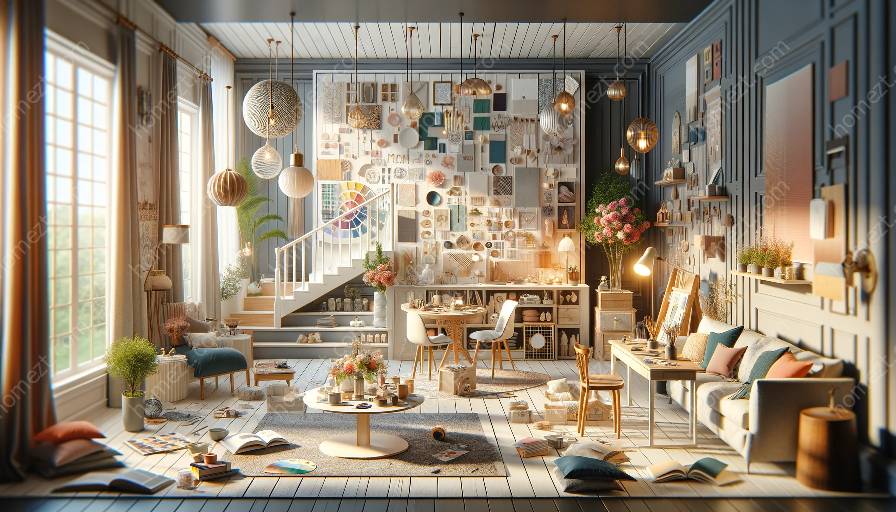Design concepts provide the foundation for creating unique and engaging interior spaces. One way to infuse originality and character into these concepts is by incorporating cultural influences from around the world. By drawing on the rich tapestry of global cultures, designers can create spaces that resonate with authenticity and offer a sense of connection and diversity. In this comprehensive discussion, we will explore how cultural influences can be seamlessly integrated into design concepts, compatible with mood boards, interior design, and styling.
Understanding Cultural Influences
Before delving into the integration of cultural influences into design concepts, it's essential to grasp the significance of cultural elements in design. Culture encompasses a wide range of elements, including traditions, customs, belief systems, art, and aesthetics. Each culture has its own unique identity and design language, which is deeply rooted in history, geography, climate, and societal values.
Why Cultural Influences Matter in Design Concepts
Cultural influences play a crucial role in design concepts as they offer a rich source of inspiration and creativity. Incorporating cultural elements can add depth, meaning, and authenticity to design concepts, making spaces more relatable and inviting. Furthermore, embracing diverse cultural influences promotes inclusivity and celebrates the beauty of global heritage, fostering a sense of unity and respect.
Using Mood Boards to Explore Cultural Influences
Mood boards serve as a visual tool for gathering and organizing design inspirations, including cultural influences. When creating mood boards, designers can curate imagery, textures, colors, and patterns that reflect the essence of a particular culture. By carefully selecting and juxtaposing these elements, designers can develop a visual narrative that captures the spirit and identity of the cultural influences they wish to incorporate into their design concepts.
Integrating Cultural Influences into Design Concepts
When integrating cultural influences into design concepts, it's important to approach the process with sensitivity, respect, and authenticity. Designers should strive to achieve a harmonious balance between honoring the cultural heritage and expressing their own creative interpretation. Here are some effective ways to incorporate cultural influences into design concepts:
- Research and Education: Start by conducting in-depth research and gaining a deep understanding of the cultural elements you wish to incorporate. This involves studying historical references, traditional art forms, architectural styles, and indigenous materials. Educating yourself about the cultural significance of specific motifs, symbols, and design principles is essential for creating authentic representations.
- Color Palette and Textures: Cultural influences often manifest in vibrant color palettes and distinctive textures. Pay attention to the color symbolism and traditional hues associated with the culture you are drawing inspiration from. Incorporate these colors thoughtfully into your design concept, whether through wall treatments, textiles, or decorative accents. Similarly, consider incorporating indigenous materials and textures that evoke the spirit of the culture, such as handwoven fabrics, natural fibers, or intricate craftsmanship.
- Symbolism and Motifs: Many cultures have symbolic motifs and patterns that carry significant meanings. Whether it's ancient symbols, religious icons, or folklore motifs, these elements can infuse depth and storytelling into design concepts. Carefully select and integrate these symbolic references into the overall design, ensuring that they are respectfully represented and resonate with the intended cultural context.
- Furniture and Artifacts: Embrace the use of culturally inspired furniture pieces, artifacts, and artisanal crafts to infuse authenticity into your design concept. Incorporate pieces that reflect the craftsmanship, materials, and design sensibilities of the culture, creating a seamless blend of tradition and modernity within the space.
The Role of Interior Design and Styling
Interior design and styling play a pivotal role in translating cultural influences into tangible, lived spaces. Through thoughtful curation and spatial arrangement, designers can bring the essence of cultural influences to life within interior environments. The following considerations are essential for effectively executing the integration of cultural influences:
- Space Planning and Layout: Consider the flow and arrangement of spaces to create an environment that respects the cultural influences being incorporated. Whether it's a communal gathering space inspired by traditional tribal meeting areas or a serene sanctuary reflective of Eastern philosophies, the spatial layout should reflect the functionality and symbolism associated with the cultural inspirations.
- Embracing Eclecticism: Embrace an eclectic approach by juxtaposing cultural elements with contemporary design features. By blending traditional and modern elements, designers can create spaces that celebrate cultural heritage while embracing a sense of contemporary relevance and global interconnectedness.
- Storytelling Through Design: Use design elements to weave a narrative that reflects the cultural influences being integrated. Whether through curated art displays, culturally significant textiles, or custom-designed installations, the design should communicate a compelling story that resonates with the essence of the culture.
Celebrating Diversity Through Design Concepts
In conclusion, the incorporation of cultural influences into design concepts is a powerful and enriching endeavor that adds depth, meaning, and authenticity to interior spaces. By embracing the diversity of global cultures and celebrating their unique contributions, designers can create environments that are not only visually captivating but also emotionally resonant. Through the use of mood boards, thoughtful design concepts, and strategic interior design and styling choices, designers have the opportunity to craft spaces that honor the rich tapestry of human heritage, fostering a sense of connection, understanding, and appreciation for cultural diversity.


























